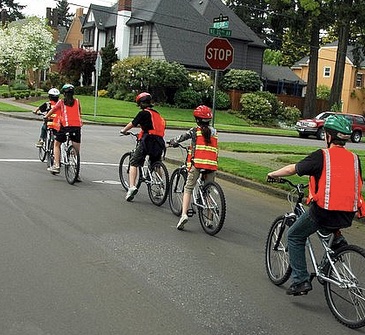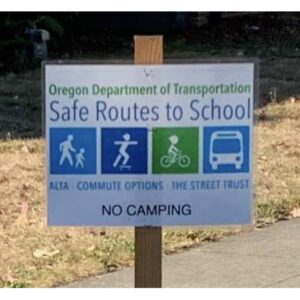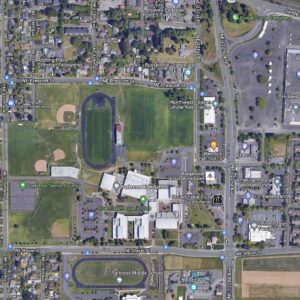Eight state legislators are chiming in their support of regional government Metro creating a regional Safe Routes to School program.
The proposal, which comes from a coalition of local transportation, health and justice advocacy groups, already has formal backing from the cities of Beaverton, Tigard, Milwaukie and Forest Grove, as well as the Beaverton School Board. It’s currently on track to become a major public issue next spring.
The idea is to dedicate some of the increasingly flexible federal transportation money that flows through Metro to giving elementary schools throughout the region an option to get a few classes in safe biking and walking, and to focus money for better crosswalks, sidewalks and bikeways around the same schools.
Moreover, the coalition is proposing to prioritize funding for schools where more than half the pupils qualify for free or reduced lunch.
In a Sept. 30 letter to the Metro council, a group of legislators led by state Rep. Jessica Vega Pederson of East Portland says that the program “results in a 40 percent increase in families who walk and bike to school.”
For example, in Beaverton walking and biking quadrupled when a federal Safe Routes to School grant funded a Safe Routes to School Coordinator to educate students and encourage walking and biking to school. As soon as the grant ended and federal funding was no longer available, the number of students walking and biking reduced by half.
Also joining the letter to Metro’s council were Rep. Jeff Reardon, Rep. Kathleen Taylor, Rep. Chris Gorsek, Rep. Rob Nosse, Rep. Carla Piluso, Rep. Alissa Keny-Guyer and Rep. Shemia Fagan. All are Democrats from the Portland metro area.
Advertisement
The subtext of a letter from state legislators is that if Metro decides to cover the relatively small amount of money for program funding — $2.7 million a year would be enough for every public elementary school in the region to offer the program — the state might in 2017 approve a gas tax hike or other plan to help cover the much larger costs of improving the streets near schools.
Those costs are spelled out in a policy document from the For Every Kid coalition.
The Metro Council has set itself a deadline of March 2016 to come to a decision on the issue.
Advocates haven’t settled on how much money they’re asking for from Metro.
Bicycle Transportation Alliance Advocacy Director Gerik Kransky said Thursday that the plan hinges on the fact that federal transportation law is about to increase the amount of money that goes to Metro and similar organizations.
Kransky and other members of the For Every Kid Coalition are pushing for those extra dollars to go toward the new regional Safe Routes program.
Also competing for that funding are advocates for faster freight access. Kransky called it “a little bit of an open question” whether freight advocates will mount a fight next fall to get their own slice of Metro’s rising federal funding.
So far, Kransky said, “we have not heard a significant backlash from those more traditional freight advocates and business advocates. … All of this looks better than years past when we’ve had these conversations.”
Correction 4:19 pm: An earlier version of this post had the wrong number of legislators. It’s Vega Pederson plus seven more.








Thanks for reading.
BikePortland has served this community with independent community journalism since 2005. We rely on subscriptions from readers like you to survive. Your financial support is vital in keeping this valuable resource alive and well.
Please subscribe today to strengthen and expand our work.
To be clear, the amount of total funding is not increasing. The amount of funding available in each of the remaining program areas is increasing. Details here:
Walking & biking to our school in the Beaverton School Distric has exploded this year. We were averaging around 40% this week, and went up over 50% yesterday on Walk/Bike to School day (312 kids out of ~600). SRTS was there to provide guidance, support, and some talks to the parents, but I think most of the walking increase was due to slashing buses for more than half our students, and a tireless effort from our school’s Green Team coordinator, who has been putting on contests, making signs, creating a forum, requesting traffic enforcement, lobbying the county commissioner, working with the principal, etc.
That said, BSD made some questionable moves in their measurements, prior to cutting the buses. There are a number of kids whose routes are more than 1 mile (I’m guessing BSD measured to the closest part of the school property, which is an 1/8th of a mile away from the school entrance), and the 1 mile route is only achievable if people walk through the private property of the HOA. Right now the HOA-owned path that these 250+ kids (plus parents) are walking & biking on is about 3-4 feet wide. There is lots of user conflict, and we’ve already had a 4th grader crash into someone and break their arm. Most people ignore the path altogether, however, and just trample the grass in a big stampede. As you might imagine, the HOA is not fond of taking on this liability, dealing with the grass being stomped into mud when the rains arrive, or the expense of improving this path, which is clearly not suitable to 300 kids all using in one 15-minute rush to school. The HOA is within their right to block the space and force the BSD to bring bus service back.
Geeze, heaven forbid the hoa actually do something good for kids. We have playgrounds that all kids play on in our hoa. Should we start checking for residency?
The HOA does lots of good things for kids. That’s not the point.
Imagine if your school district cut buses for school kids in your area because it was determined that IF they cut through YOUR backyard, they would now be within 1 mile of the school. They start by using the little stone path you have back there. But now there are 300 kids walking through your backyard, most of them walking on the grass instead of the path, and then one of them breaks their arm, and the community is asking YOU to spend $10,000 to upgrade the path to protect you from liability issues.
You don’t like the idea of spending $10,000 on a path in your backyard for a problem created by the BSD. Does that mean you don’t like kids?
This does sound like a horrible situation and I appreciate your concern for homeowners. What kills me though is that we all just meekly accept the constant noise, pollution, and endangerment to our lives of motor vehicles everywhere we go and we’re considered freaks if we ever question their place in our world—while it’s the easiest thing in the world to quash walking routes because of their threat to people’s privacy and peace.
You are sandboxing the sidewalk issue into something related to lawyers. I am familiarity with the relationship between hoa entries and cities. Grass grows back, people have walked in dirt of thousands of years and still today. If the sidewalk isn’t wide enough, lay gravel for the needed width. Hoa common areas are just that, common to everyone. The bus analogy is false and ridiculous.
A better analogy might be, what if the city posted the hoa sidewalk to their user map? So what if they did? I prefer a world where children use the path. If that offends people and they can’t bring themselves to improve the path, that goes to their state of mind and human quality.
Hoa entities have a long and sordid history of screwing people….mine included. It would be a great day to see our paths overrun with children walking to school. This is a not s public problem. The whole liability issue is moot. If they don’t want liability, fence all green space off. Hoa entities have no problem employing lawyers.
The HOA common areas are open to everyone only because they allow them to be so. They are actually privately owned and maintained, and they HOA has a right to restrict their usage if they wanted to do that.
Oregon law requires the BSD to provide transportation to elementary students living over 1 mile from school, measured along public routes. By that measure, we currently have students living more than 1.25 miles away who are not being provided bus service. The ONLY way the BSD was able to get to 1 mile was by including the privately-owned path in the route, and by measuring the distance to the far corner of the school property. One bus route costs an estimated $37,000 a year. Do you suppose they were financially motivated to ’round down’ the distance?
We are supporting walking/biking, and the more the better. However, those students at the far end of route are much more likely to be driven than any of the students living closer — I would bet that’s where most of our drivers are coming from.
So the bsd looked on a map, saw a sidewalk but didn’t research the particulars of that sidewalk and now…..what? What is the apocalyptic end result? Dead grass…a rut…a broken arm? Again, what is the point of the path?
Are you suggesting the hoa only envsions children with lineage leading to hoa members use that path? What about guest of hoa members? See how that gets weird?
I would like to see this hoa restrict access to a walkway that connects two public areas. How would they do it?A key only given to members? A keypad? Secret password? Old cranky hoa board members standing guard with cage free eggs ready to drop poultry rain from the sky when the first non hoa child dares to tread one sneaker on the golden path?
Maybe they should go to the news. Perhaps they could find their oldest member to lay out the most dire situation and most severe consequences in the best Beaverton resident way possible.
Until then, eggs are only getting more expensive.
Is Share the Road concerned only with elementary school students? Or can secondary schools & students become involved? The routes to Cleveland H.S., i.e., are about as unsafe as they come, and discourage all but drivers. No signage, no crosswalks, no traffic calming–nada. I’ll bet a lot more kids would bike and walk to school there if steps were taken to calm things down and protect them, esp. on SE Powell and SE 26th.
Also, encouraging high school students to walk and cycle would take at least a few teenage drivers off the road–that will improve everyone’s road conditions.
🙂
Rachel,
PPS is currently working on an assessment tool to identify Safe Routes to all schools within its jurisdiction. It is a GIS based tool that could be used by any school district. Page 16:
http://www.pps.k12.or.us/files/board/04-28-15_Final_Packet.pdf
PBOT works with elementary and middle schools.
http://www.portlandoregon.gov/Transportation/article/391663
KATU interactive map of designated routes and injury crashes:
http://www.katu.com/news/local/safe-routes-portland-public-schools-2015-walking-accidents-pedestrian-students-walk-322308842.html
Thank you, paikiala. I was just on the TSP site last night (another for which you kindly provided links not long ago) trying to figure out which meetings would be useful for me to go to. I was looking esp. at the Pedestrian Advisory Committee on 10/20. Hate to bother you but if you can give me any direction there, it’d much appreciated!
p.s…also trying to decipher which section of the Stage 2 Discussion Draft of the TSP I should comment on re: my concerns for SE 26th between Clinton and Powell.
CHS actually has a surprisingly high number of kids who ride to school (check out the bike racks on a school day), especially given its location.
Regarding SRTS, they need an organizer, and I plan on being that person next may for bike to school month (I’ve been talking to BTA about how the high schools seen left out and that we need to change that). Would love some help from a neighborhood resident of you’re interested!
A secondary “nudge” might be for police to hover around schools with heavy drop-off traffic to catch cell phone violations by parents. Let parents who are habitual drivers feel some heat.
I think this should be enforced on cyclists as well. See it all too often. And the full headphone thing, too.
You’d like the police to pull cyclists over for things that aren’t illegal?
I would settle for strictly enforcing the 20mph school zone speed limits, or maybe even just requiring property owners to trim their shrubs when they are blocking the 20mph sign. Getting 90% of parents to stop before the crosswalks within at least a block of their school would be amazing.
For concerns about sign visibility, for which property owners are liable, contact 823-SAFE.
I did call a couple weeks ago (thanks again for the link) about the obstructed 25mph signs on SE 26th between Clinton and Powell. No action, so far. I expect there’s probably a reasonable wait, but is this one of those situations where I should keep calling to get some action?
Usually, at the beginning of each school year, Portland Police do this type of enforcement to remind people driving near schools to be more aware.
In our experience this year, SRTS did not handle any of that. They provided guidance and support, but if we want enforcement of a dangerous intersection, we have to do it. And that’s fine, but each neighborhood needs some strong leadership to take this on.
Here’s an effective way to raising walk/bike numbers:
http://www.thenational.scot/news/car-ban-at-schools-to-create-safer-streets.7878
I’d like to see SRTS and FEK advocate for a trial run of this at a school. I’d like to see it done at our school, but who knows what kind of hoops you’d have to jump through to make it happen. We could even just start by closing the drive through lane, and force people to drop off from further away, but god forbid you inconvenience any drivers.
Love love love this idea. At the very least I would like to see a no-idle zone along the sidewalks next to schools. Why do small kids (even those who are driven to school) have to walk through a cloud of soot, benzene, and carbon monoxide to get to the door of their school?
Stephanie,
http://www.portlandoregon.gov/transportation/article/264061
Dan,
http://www.portlandoregon.gov/transportation/article/218138
This is excellent, thank you. We have been promoting a similar program (we call them ‘Alternate Drop Spots’) but I don’t think people understand the concept yet.
I’m thinking of a simple bet for our school, that we should have done for walk/bike day:
Most of our walkers arrive from the back side of the school. Due to district ‘safety’ policies, kids have to walk around the building and enter through the front door, the door which is closest to the parking lot. Suppose we go over 50% walking mode. Would the school change the entrance door for one day to the door on the back side of the school to reward the walkers? Could be a fun bet!
Perhaps the entrance should encourage walking anyway.
Totally agree. Most schools now are built to look like a large drive thru.
My school allows drivers to sit in the fire lane and wait for their snowflakes. It’s come down to “I have a child in a car seat and don’t want to take them out. So I need to stand in the fire lane and call to my child as they are leaving.
I just pull into a parking spot and walk my other two kids to the door. It works well.
If you ever want to see entitled, listen to a school parent who drives.
Even back when we used to drive the boys to school, we never went into the school parking lot — that’s just crazy! We parked a block or two away and walked. Saved a ton of time.